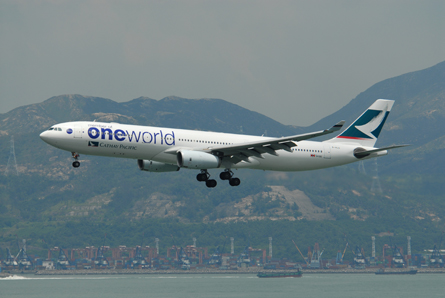The Cathay Pacific Airways Airbus A330-300 involved in a high-speed landing at Hong Kong International Airport (HKIA) on 13 April had issued a Mayday signal while preparing for landing.
The aircraft's centralised monitoring system had reported problems with the A330's twin Rolls-Royce Trent 700 engines at least five times throughout the flight, says a preliminary report issued today by Hong Kong's Civil Aviation Department.
Despite this, authorities say there was no engine or fuel system-related problem reported in the maintenance log of the aircraft, registration B-HLL, before it left Surabaya for Hong Kong at 01:24 GMT in an uneventful departure.
While the aircraft was climbing, the flight crew noticed minor engine pressure ratio fluctuations on engine no. 2. The other engine also had similar fluctuations "but within a narrower range", says the report.
 |
|---|
At 01:58 GMT, the aircraft's monitoring system displayed the message "Engine 2 Central System Fault".
"As parameters on both engines were normal except the slight fluctuation of the engine pressure ratio indications, both the flight crew and the maintenance control [of Cathay's engineering department] were satisfied that it was safe for the flight to continue," says the report.
A similar message concerning engine no. 2 appeared on the monitoring system again at 03:16 GMT. At 05:19 GMT, the system displayed "Engine 1 Central System Fault" and "Engine 2 Stall" within "a short period of time", says the report.
The aircraft then sent an urgency signal to Hong Kong Air Traffic Control, advising that engine no. 2 was at idle thrust. The aircraft requested for priority landing, which was allowed.
While the aircraft was 45 nautical miles from HKIA and was about to level off at 8,000ft above mean sea level, the monitoring system displayed "Engine 1 Stall" at 05:30 GMT. A Mayday signal was declared at 05:32 GMT.
"During the final approach with both thrust levers at the idle position, No 1 engine was stuck at about 74% N1, and decreased to about 70% N1 during touchdown, and No. 2 engine was stuck at about 17% N1 throughout the approach and landing," says the report.
The aircraft landed at 05:43 GMT at a ground speed of 230kt with a landing weight of 173,600kg, with the pilot applying maximum manual braking before the aircraft came to a complete stop on the runway.
While landing, the lower cowling of engine no. 1 contacted the runway surface briefly, resulting in the automatic deployment of spoilers. Only engine no. 1's thrust reverser deployed.
Five main tyres of the aircraft were deflated, and there was fire and smoke on the main wheels, says the report.
The pilot then ordered an emergency evacuation of the 309 passengers and 13 crew members. During the evacuation, 57 passengers were injured. One of the 57 suffered serious injuries, adds the report.
An investigation team comprising officials from Hong Kong, France, UK, Indonesia and the USA is looking into the incident, with assistance from Airbus, Rolls-Royce and Cathay experts.
"The engines, their control systems and the fuel system are under detailed examinations to determine the possible causes of the abnormal engine behaviour," says the report, adding that engine fuel components and samples have been sent to the UK and USA for analysis.
Investigations are expected to take more than a year to complete, says the report.
Related Links:
Source: Air Transport Intelligence news























